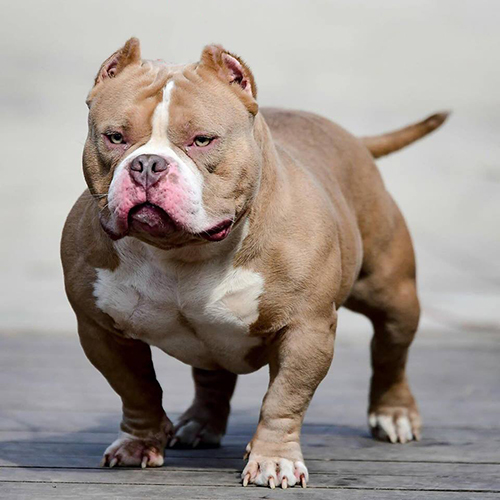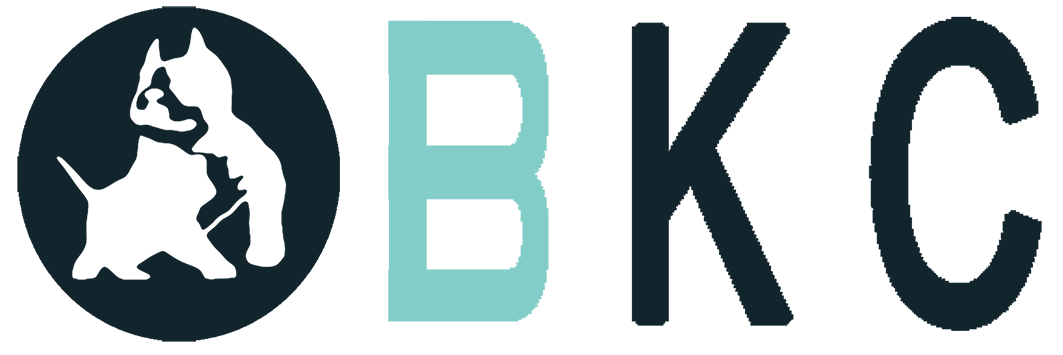
HISTORY
The American Bully is a breed that breeders have developed over time, by taking certain strains, with specific aspects of the American Staffordshire Terrier and cross breeding it with various Bulldog breeds to take the look to the extreme. The beginning strains of the breed began to be more commonly seen in the late 1980’s and early 1990’s, when the West-coast strain of APBT/Bulldog was bred to the East-Coast strain of APBT/Bulldog. At the time, the West-Coast boasted a bigger American Bully, often mixed with bigger Mastiff and Bigger Bulldog breeds; whereas the East Coast strains often crossed the APBT with shorter, more compact bulldog breeds such as the English Bulldog. Mid- 2000’s, the look caught fire (due to the mixtures starting to take on a more consistent form) amongst the Bully community, and later, the world.
General Impression
The American Bully should give the impression of an animal so STRONG and MAJESTIC; with immense strength and power, that you would think God, himself, cuffed his Heavenly hands together; and when they opened, this breed is what he presented on a Golden cloud. He will have the silhouette of a Demi-God-Dog, with well-defined chiseled muscle throughout that of a stout frame. His head is well-pronounced, sculpted and wide in proportion to his broad body. His skeletal system is substantial, to properly bed the many muscles of the “God-Dog”, American Bully. His movement is of POWER and Grace, (Unanimously) as his thunderous gait rolls perfectly as he trots. Most females will be slightly lighter in build and bone, (although some females may take on the size and masculine appearance of male American Bully) yet just as magical, if not MORE.
The American Bully as we know it, is more bulldog like (Bullier) than the standard American Staffordshire Terrier, but like the American Staffordshire Terrier it retains all the virtues of the breed such as: Tighter skin, muscle definition, tight feet, awesome confirmation and those signature almond-shaped eyes.
Bullies are usually more massive, wider and stockier, with much lower chest-drop than the standard American Staffordshire Terrier. Their headpiece is something to be admired and is a source of pride to all Bully fanciers.
HEAD
Head is to be large and prominent with top skull being flat, not domed between ears. Head will be large, but proportionate to body size. Eyes to be set apart, and low on skull, generally set directly underneath the medial border of the helix (part of ear which sits on top of the skull). Muzzle to be of short or medium length with a very pronounced stop and fall away, with well-developed and chiseled cheek muscles to give the impression of strong biting power on lower mandible. Lower jaw shall be well developed not weak and should be hidden under the dog’s flew when mouth is closed. General impression should have the appearance of good gripping strength. Face outline should not be completely circular, or completely squared, but a mixture. The top of the head should give the impression of a square shape, while the bottom should give the impression of a half circle. Ears are to be set high on the skull and not to close together. Face may have slight wrinkles and loose skin around the cheek, and forehead area. Also slightly loose flews acceptable but not desirable. Bite is to be scissor. Upper teeth to meet closely over lower teeth.
Faults
Head disproportionate (too big/too small)
Skin too loose
Head is completely circular or completely squared
Head domed between ears
Underbite to exceed ¼”
Overbite to exceed ¼”
Eyes set too far apart
Eyes too close together
Eyes set too high/low
Long, pointy muzzle
Circular eyes
Bulging eyes
Sunken eyes
Wry jaw
Eyes differing in color
Disqualifications
Albinism (Pink eyes, lack of pigment)
Nose turned up to the point where face is flat/Slanted
Teeth protruding while mouth closed
Wrinkled beyond breed type
Neck is to be short to medium length with a medium to large arch and widening from the base of the skull to the shoulder blade. Slightly loose skin in this area is acceptable.
Faults
Weak/Thin neck
Long neck
Excessive wrinkles
EARS
Cropped or uncropped is permissible. Uncropped ears should be either rose, half prick or stand erect. Full drop is permissible but not desirable.
FOREQUARTERS
Straight, well boned forelegs set rather far apart at the shoulders, showing no looseness. Feet are of medium size with tight pasterns, which are strong, tight and upright. Feet may turn out a little at the pastern but is not desirable. Elbows should sit directly underneath shoulders, but a slight protrusion in the American Bully is permissible. General impression of an American Bully front should appear to form a square from tip of feet to the outside of forearms to the top of the shoulders. Also a more curved front at the shoulders are permissible in the American Bully, as long as elbows sit underneath shoulders, with straight, tight feet.
Faults
Completely Bowed front
(2)
HINDQUARTERS
Hindquarters should be well muscled. Good inner and outer muscling of the thigh. Rear stifle to have adequate bend with hocks well let down, forming an upside down capital “L”. Legs are parallel when viewed from the rear.
Faults
Cow hocked
Sickle hocked
No bend in stifle
Over angulated
High set hocks
BODY
The body of a Bully is muscular and compact. Short across the back being closely coupled. The topline should slope slightly from the point of the shoulders to over the hindquarters and fall away from the croup to the tail. Being that the breed has bulldog incorporated from its inception, and is a breed in process; a slight rise in the loin is permissible, but not desirable. The front is wide with a deep brisket. Ribs are to be well sprung and evenly spaced and a slight tuck at the waist. Chest is to be deep and barrel shaped.
Faults
Body length longer than body height
Weak hip placement
Thin rib cage
TAIL
Short in comparison to body. When the dog is relaxed, the tail is carried low and extends approximately to the hock. Appears to be carried like an old fashion water pump handle when viewed from the side. Set low on rump tapering to a fine point. When the dog is moving, the tail is carried level with the backline. When the dog is excited, the tail may be carried in a raised, upright position (challenge tail), but never curled over the back (gay tail).
Fault
Challenge tail
Kinked Tail
Short Tail
Long tail
Disqualification
Gay tail
Bob tail
Docked tail
Screw tail
COLOR
Any color or color pattern is permissible except Merle.
Disqualification
Merle
HEIGHT AND WEIGHT
Males should weigh 60 to 95pounds fully grown. Height should be 15 to 19 inches tall.
Females should weigh 50 to 80 pounds fully grown. Height should be 14 to 18 inches tall
EYES
Any color acceptable. Must have pigmentation around eyelids. Eyes are to be set low and far apart on the skull.
Disqualification
Pink eyes, Albinism
(3)
GAIT
Gait will be heavy with a tendency to roll. Dog should convey a demeanor with self confidence and an impression of great power and a zest for life. When trotting, roll may become accentuated. Front legs may turn slightly out. Rear legs to track in a straight line. As speed increases legs should converge to the centerline.
Faults
Traveling to close
Traveling to wide
Legs not traveling on the same plane
Crossing over
Pacing
Hackney movement
COAT
Coat should appear short, smooth, glossy and in good condition. Coat should be moderately stiff to the touch when brushed in one direction.
Faults
Wavy coat
Sparse coat
Disqualifications
Long coat
No coat
DISQUALIFICATIONS
Extreme shyness or viciousness
One or both testicles not dropped (by six months of age)
Deafness in one or both ears
Albinism in eyes
Long coat
Standard written by Roger Calderon on July 23, 2003, and permission given to The Original Bully Kennel Club to utilize. Amended by Mario Johnson (OBKC™ President) on July 12, 2018.
